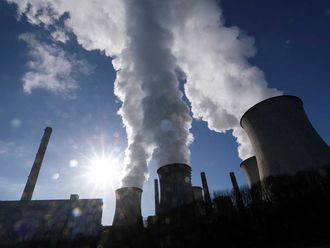New York: Wall Street slumped on Tuesday, pushing all three major indexes into negative territory for the year, after weak factory data from China heightened fears of a slowdown in the world’s second-largest economy and its effect on global growth.
Energy stocks led the fall, with the S&P energy index declining 3.6 per cent. The weak China data pushed down oil prices more than 4 per cent, snapping three days of gains.
Chevron and Exxon were down about 4 per cent.
At 11:04am. ET (1504 GMT) the Dow Jones Industrial Average was down 357.81 points, or 2.16 per cent, at 16,170.22.
All the 30 Dow components were in the red.
The Nasdaq composite was down 80.54 points, or 1.69 per cent, at 4,695.97.
The S&P500 was down 41.57 points, or 2.11 per cent, at 1,930.61. All the 10 major S&P sectors were lower.
Data showed that China’s manufacturing sector shrank at its fastest pace in three years. The country’s manufacturing Purchasing Managers’ Index (PMI) fell to 49.7 in August from 50.0 in July.
“The PMI was below 50, which is a psychologically important level and puts into real focus the fact that China is contracting,” said Joe Rundle, a senior sales trader at ETX Capital.
Factory data in the United States was also weak. The pace of growth in the US manufacturing sector slowed in August to its weakest in over two years, according to the Institute for Supply Management.
Adding to the nervousness, International Monetary Fund head Christine Lagarde said global economic growth was now likely to be weaker than had been expected just a few months ago.
Some US federal funds futures rose to session highs after the lower-than-expected US factory data, implying traders raised their bets the Federal Reserve would raise rates even more slowly than they had previously thought. [ ID:nL1N1170ZF] “The volatility is here to stay for a while or at least till the Fed gives us an indication regarding a rate increase,” said Art Hogan, chief market strategist at Wunderlich Securities in New York.
“Right now, they are being quite cagey.” The CBOE Volatility index, known as Wall Street’s “fear gauge”, was up 10.4 per cent at 31.41, above its long-term average of 20. The index had spiked to 53.29 last Monday.
The financial index fell 2.72 per cent as the weak data reduced the odds of a rate hike this month. Stocks of US banks such as JPMorgan, Wells Fargo and Citigroup fell 3-4 per cent.
Netflix was down 6.2 per cent at $107.80 after Variety reported that Apple was looking to move into the original programming business. Apple fell 1.3 per cent to $111.39.
Dollar Tree fell 6.9 per cent to $70.95 after its quarterly sales rose less than analysts had expected.
Declining issues outnumbered advancers on the NYSE by 2,612 to 373. On the Nasdaq, 2,147 issues fell and 538 advanced.
The S&P500 index showed no new 52-week highs and seven new lows, while the Nasdaq recorded six new highs and 29 new lows.












